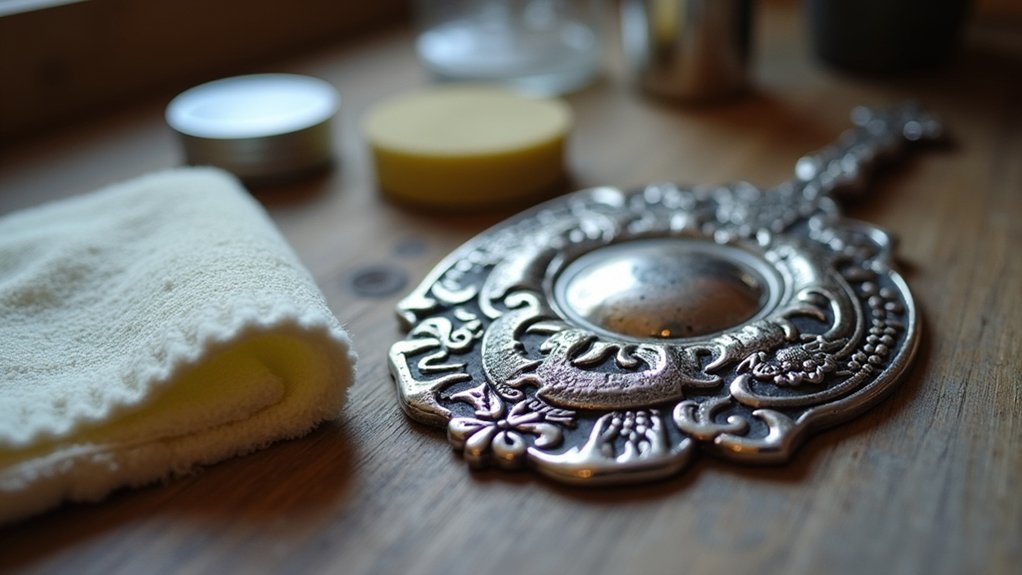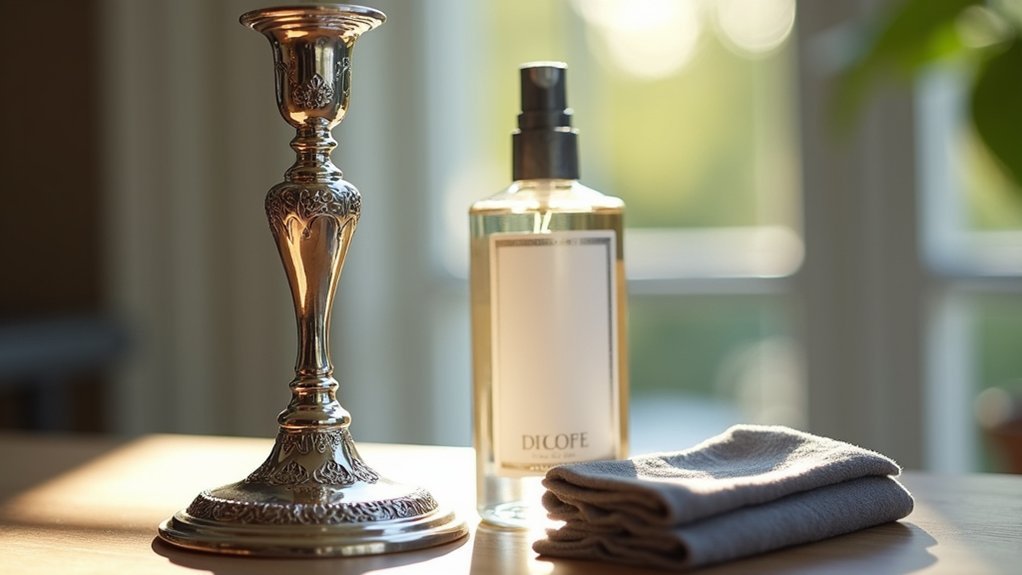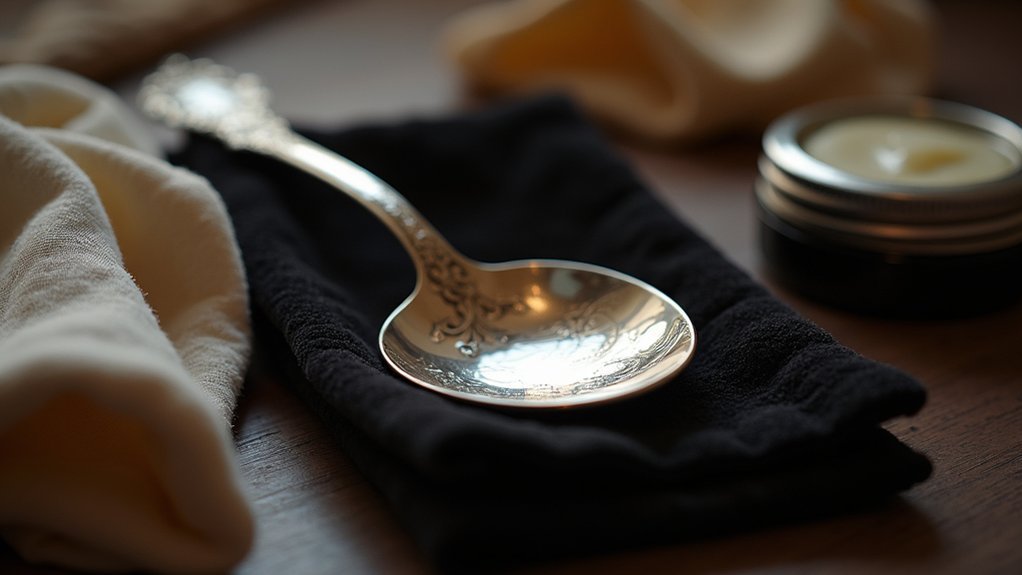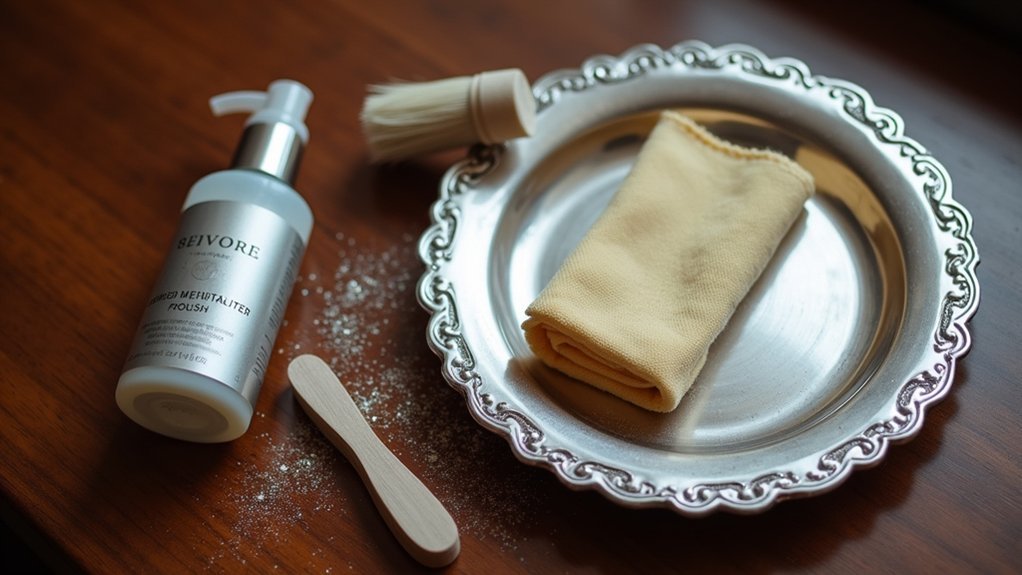You can restore silver’s brilliance using five proven techniques. Start with essential tools like microfiber cloths and nitrile gloves, then try the baking soda and aluminum foil method for natural cleaning. Commercial silver polish delivers professional results when applied properly, while plain toothpaste works for gentle spot cleaning. Don’t forget proper storage in airtight containers to prevent future tarnishing. Master these methods and you’ll discover the specific steps that make each technique incredibly effective.
Essential Tools and Materials for Hand Polishing Silver

Before you begin polishing silver, you’ll need to gather the right tools and materials to guarantee professional results without damaging your precious items.
Start with a microfiber cloth for gentle buffing that won’t scratch surfaces or leave lint behind. Nitrile gloves prevent oils from your hands transferring onto silver, which accelerates tarnish formation.
Always wear nitrile gloves when handling silver to prevent natural skin oils from accelerating tarnish and causing premature discoloration.
Mix mild dish soap like Dawn with warm water as your primary cleaning agent to remove dirt before polishing silver pieces. Choose quality silver polish such as Wright’s or Herman’s Simply Clean for protection and enhanced shine.
Cotton balls help apply polish evenly and reach intricate designs. These essential tools make certain you’ll achieve professional-quality results while preserving your silver’s beauty and value.
The Baking Soda and Aluminum Foil Method
When you’re dealing with heavily tarnished silver that needs a powerful yet gentle cleaning solution, the baking soda and aluminum foil method delivers impressive results through a fascinating electrochemical process.
You’ll line a bowl with aluminum foil, then add boiling water mixed with baking soda—approximately one tablespoon per cup of water.
Ensure your silver pieces touch the foil to trigger the chemical reaction that transfers tarnish from your silverware to the aluminum.
This cleaning method requires soaking for 2 to 10 minutes, depending on tarnish severity. The electrochemical process effectively removes even stubborn buildup with minimal effort.
After soaking, remove your silver and buff it with a soft microfiber cloth.
This technique’s simplicity and low cost make it exceptionally popular for restoring heavily tarnished items.
Using Commercial Silver Polish for Professional Results

Commercial silver polish offers the most reliable path to achieving professional-grade results when you’re serious about restoring your silver’s original luster. Always read manufacturer’s instructions before starting.
Apply polish using a non-abrasive cloth, working on small sections to effectively remove tarnish without surface damage. These products contain gentle abrasives that restore shine while preserving the patina on valuable antique pieces.
Focus on thorough application, then begin buffing silver with circular motions until you’ve achieved the desired brightness.
After completing the polishing process, rinse items under warm water to eliminate any residue that could cause future tarnishing. This final step guarantees you’ve removed all polish traces.
Regular use creates a protective layer that’ll help maintain shine between cleanings, keeping your silver looking professionally polished.
Gentle Cleaning With Toothpaste and Soft Cloths
While commercial polish delivers professional results, you don’t always need specialized products to maintain your silver’s appearance. Toothpaste offers an effective gentle cleaning alternative when you follow proper techniques.
Choose plain, non-gel toothpaste and apply small amounts to a soft cloth. Work tarnished areas using circular motions to lift buildup without scratching. After polishing, rinse thoroughly with warm water to remove all residue, then dry immediately with a clean cloth.
| Step | Action | Purpose |
|---|---|---|
| Prepare | Apply toothpaste to soft cloth | Prevents direct contact |
| Polish | Use circular motions on tarnished areas | Removes tarnish gently |
| Finish | Rinse and dry completely | Prevents water spots |
Reserve this maintenance method for occasional use, as frequent toothpaste cleaning can create micro-scratches that diminish your silver’s shine over time.
Maintaining Silver Shine Through Proper Storage and Care

Proper storage proves just as essential as cleaning techniques for preserving your silver’s lustrous appearance.
Store silver in airtight containers or anti-tarnish bags to minimize exposure to humidity in the air, which accelerates tarnishing. Place camphor blocks or silica gel packs inside storage areas to absorb excess moisture. Avoid using newspaper or non-acid-free materials for wrapping, as these leave harmful residues on silver items.
Airtight storage with moisture-absorbing materials protects silver from humidity and harmful residues that accelerate tarnishing.
Dust silver regularly with a soft cloth to prevent particle buildup that attracts moisture. Keep pieces away from sulfur-containing products and environments, which rapidly accelerate tarnish formation.
When you do need to clean tarnished pieces, gentle maintenance prevents the need for harsh silver polishes. Consistent storage practices greatly extend the time between polishing sessions.
Frequently Asked Questions
How Do You Polish Silver by Hand?
First, you’ll wash the silver with mild dish soap and warm water. Apply gentle polish to a soft cloth, rub in circular motions, then rinse and buff dry with microfiber.
What Is the Best Home Remedy to Clean Silver?
You’ll get the best results using aluminum foil lined bowls with baking soda and hot water. The chemical reaction removes tarnish effectively, making it superior to other home remedies for cleaning silver.
What Do Antique Dealers Use to Clean Silver?
You’ll find antique dealers use gentle polishes like Wright’s or Herman’s Simply Clean with soft cotton cloths. They’ll apply minimal pressure, work in small sections, and store pieces in anti-tarnish bags.
Will Dawn Dish Soap Remove Tarnish From Silver?
Dawn dish soap can remove light tarnish from your silver when you mix it with warm water. You’ll need to soak items briefly, scrub gently, then rinse thoroughly for best results.
In Summary
You’ll find that consistent care makes all the difference in preserving your silver’s beauty. Don’t wait until tarnish builds up—regular maintenance prevents heavy cleaning sessions. Store your pieces properly, use these techniques when needed, and you’ll keep your silver looking brilliant for years. Remember, gentle handling and the right tools will protect your investment while restoring that mirror-like shine you’re after.





Leave a Reply